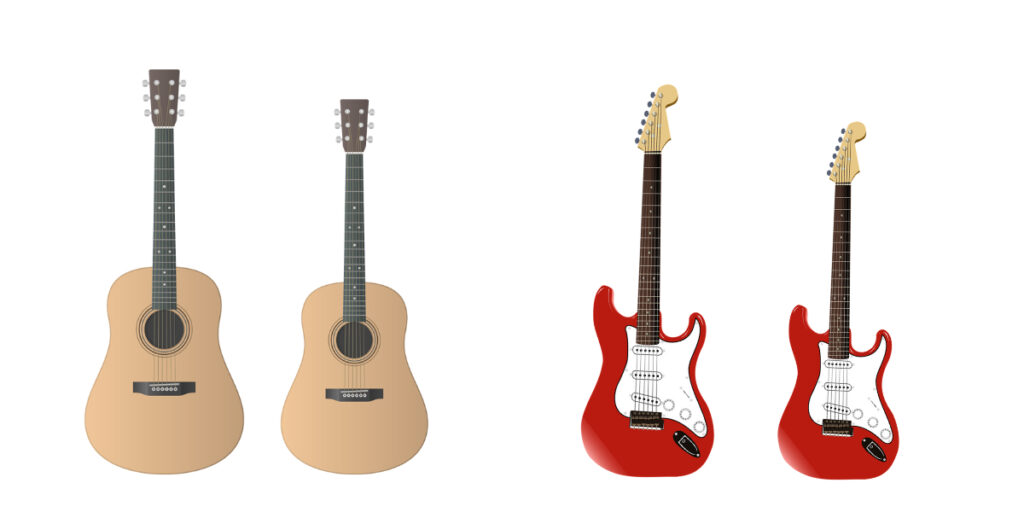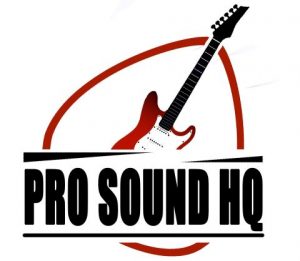If you’re looking to buy an acoustic or electric guitar, one of the first things you’ll need to figure out is what size you need. The two most common options are 3/4 and full-size, but what’s the difference, and which is best for you?
Here’s the quick answer.
A 3/4 guitar is usually 34″ in length, whereas a full-size guitar is typically around 40″ long. 3/4 guitars are best for children (12 and under) whereas full-size guitars are preferred by most teenagers and adults. Full-size guitars sound louder, warmer and fuller than 3/4 guitars.
| 3/4 Guitar | Full-Size Guitar |
| Scale length is 22”-23” | Average scale length is 24”-26” |
| Body length is 18”-19” | Average body length is 15”-16” |
| Overall length is 40” on average | Overall length is 34” on average |
| Acoustic guitars weigh approximately 3 lbs | Acoustic guitars weigh approximately 4 lbs |
| Electric guitars weight approximately 6 lbs | Electric guitars weigh approximately 8 lbs |
| Strings are under less tension so easier to fret | Strings are under more tension so harder to fret |
| Ideal for players under 5’ | Best for players over 5’ |
| Designed for children | Designed for teenagers and adults |
| Sound brighter and thinner | Sound warmer and fuller |
| Cheaper | More expensive |

3/4 (Mini) vs Full-Size Guitar Specifications
There are several differences between 3/4 (mini) and full-size acoustic and electric guitars:
- Scale length
- Body dimensions
- Overall length
- Neck dimensions
- Weight
- String gauge and tension
Scale Length
The scale length of a guitar measures the distance from the nut to the bridge of the guitar.
- On average, 3/4 acoustic guitars have a scale length of approximately 22″-24″, whereas full-size acoustic guitars have a scale length of 25″-26″.
- On average, 3/4 (mini) electric guitars have a scale length of 22″-23″, whereas full-size electric guitars have a scale length of 24″-26″.

Body Dimensions
The body dimensions of different acoustic and electric guitars does vary considerably so I’ll compare like-for-like 3/4 and full-size models here.
Martin Dreadnought Acoustic Guitars
| Full-Size Martin D-18 Dreadnought | LX1 Little Martin (3/4 Dreadnought) | |
| Upper Bout Width | 11.5” | 8.75” |
| Waist Width | 10.75” | 7.63” |
| Lower Bout Width | 15.5” | 12.5” |
| Depth | 4.75” | 3.0” |
| Body Length | 19.75” | 15.75” |

Stratocaster Electric Guitars
| Full-Size Stratocaster | Mini Stratocaster | |
| Body Width | 12.75” | 11.0” |
| Body Depth | 1.5” | 1.5” |
| Body Length | 18.0” | 15.5” |
Overall Length
Again, the overall length does depend on the exact model in question as different guitars have different body and scale lengths even though they are still considered to be full-size. So, let’s take a look at some examples.
- A full-size Martin Dreadnought has an overall length of 40.75″ whereas the 3/4 LX1 Martin Dreadnought has an overall length of just 34.0″
- A full-size Stratocaster has an overall length of 38.94″ whereas the 3/4 Stratocaster has an overall length of 34.5″.

Neck Dimensions
Different guitars have different neck profiles and thicknesses. Some full-size and 3/4 versions of the same guitar model will have the same neck specifications in terms of fretboard width, neck depth and overall shape. Some 3/4 versions however will have slimmer feeling necks with a narrower nut width.
Let’s take the Martin Dreadnoughts as an example.
Both the full-size D-18 model and the 3/4 size LX1 have the same neck profile, however, the fretboard width on the LX1 is narrower (1.68″) compared to the full-size Martin (1.75″).
Weight
Since 3/4 guitars are smaller both in terms of the body and scale length, they are lighter compared to the full-size versions. Here is a table comparing the average weight of popular mini and full-size acoustic and electric guitar models.
| Guitar | Full-Size Version | ¾ Version |
| Martin Dreadnought Acoustic Guitar | 4 lbs | 3 lbs 7 oz |
| Taylor Dreadnought Acoustic Guitar | 4 lbs 13 oz | 3 lbs |
| Stratocaster Electric Guitar | 8 lbs | 6 lbs |
| Jazzmaster Electric Guitar | 8.5 lbs | 8 lbs |
String Gauge and Tension
Full-size and 3/4 versions of the same guitar typically come with the same string gauge (thickness).
- Acoustic guitars usually have a 12 or 13 gauge string set
- Electric guitars usually have a 9 or 10 gauge string set
Since 3/4 guitars have a shorter scale length but the same string gauge, the strings are under less tension. When the strings are under less tension they are easier to fret and require less finger string which is one reason why 3/4 guitars can feel easier to play for beginners compared to full-size guitars.
The downside though, is that because the strings are under less tension, they will not hold tune as well.

Should Beginners Use 3/4 Guitars?
A 3/4 acoustic guitar is a good option for a beginners (adults and children) if they have a smaller frame as it will feel more manageable and the strings are under less tension so feel easier to fret.
However, adults and teenagers with average or larger frames will typically feel more comfortable with a full-size guitar rather than a 3/4 guitar even if they are beginners.
3/4 guitars are generally designed for children, or players with a smaller frame (less than 5′). With that said, some adults do still use 3/4 guitars. Ed Sheeran for example uses a 3/4 dreadnought, the Martin LX1.
Getting a 3/4 guitar is also quite useful if you plan on travelling with the instrument as it will take up considerably less space.
An acoustic guitar with a 3/4 scale will be more suitable for an adult compared to a 3/4 electric guitar. Most acoustic guitars are longer and larger than electric guitars so a 3/4 acoustic won’t feel as small. Adults will usually feel that the scale and body size of a 3/4 electric guitar is too small.
I personally have a small frame and started with a mini Stratocaster when I was 8 years old. At the time this was the perfect size for me as a younger beginner player, but when I had a growth spirt at about 12 years old I quickly outgrew it and felt more comfortable with a full-size electric guitar.
3/4 vs Full-Size Tone
Let’s start with acoustic guitars.
A full-size acoustic guitar will sound louder and have more low-end frequencies giving the guitar a warmer and fuller sound compared to a 3/4 guitar. In comparison 3/4 guitars sound thinner but also brighter due to the lack of bass frequencies.
Check out this YouTube video comparing the tone of a 3/4 and full-size acoustic guitar.
Okay so what about electric guitars? Well, here the size of the guitar does not make as much of a difference because the tone is mainly dictated by the pickups.
Full-size electric guitars will usually have more sustain compared to 3/4 (mini) guitars as they are heavier and more resonant as a result. However, the difference isn’t huge when comparing two of the same model.
3/4 electric guitars will usually use cheaper pickups compared to full-size electric guitars because they are designed to offer a guitar at a more affordable price point for beginners and children. Hence, the tone of a 3/4 and full-size Strat can sound quite a bit different, not only due to the size of the instrument.
Frequently Asked Questions
Is a 3/4 guitar too small for adults?
For most adults a 3/4 guitar will feel too small. 3/4 acoustic guitars are larger than 3/4 electric guitars, so may feel okay for adults with a smaller frame, but the majority of adults will feel that a 3/4 electric guitar is too small.
When should you switch from a 3/4 to a full size guitar?
If you are over 5′ then it is a good time to switch from a 3/4 to a full size guitar. Generally, players over 12 years old will feel more comfortable with a full-size guitar compared to a 3/4 guitar.
Is a 3/4 guitar better for small hands?
Many 3/4 and full-size guitars have the same neck profiles and thicknesses, so a 3/4 guitar will not feel better if you have smaller hands. If you have small hands, try choosing a C or D-shape neck with a shallow neck depth (ideally less than 0.85″ at the first fret).
